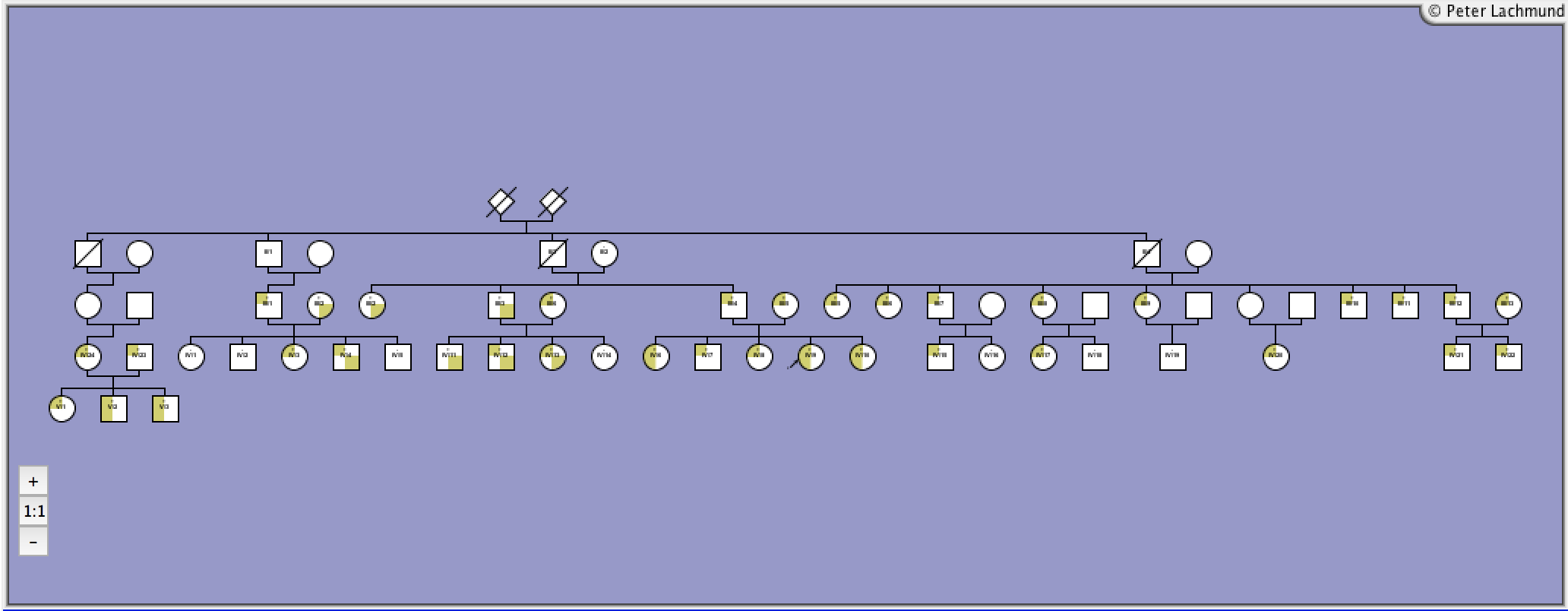Details Of Published TSH Receptor Mutation
Pro 68 Ser
c.202C>TInactivating TSH Receptor Mutation
Type
loss
Manifestation
family
Exon
1
Legend:

Male

Female

Unknown

Deceased
+
Mutation
-
Wild-Type

Heterozygous

Heterozygous

Compound Heterozygous

Homozygous

Hypothyroid

Hypoplastic Gland + Hypothyroid
P
Index Patient
Molecular Characteristics:
Family 1 -Pedigree 1 (Tenenbaum et al.):
IV/6, IV/9 (proposita), IV/10, V/2, V/3: L635V/L635V
III/2, III/3, III/13, IV/11: P68S/wt
IV/4, IV/12, IV/13, IV/22: P68S/L635V compound heterozygous
20 individuals: L635V/wt
3 further individuals: L635V/wt, 1 patient with P68S/wt detected by genotype screening in local population: L635V/wt one individual
P68S/wt: 2 individuals
n.b. III/2 and III/1, III/3 and III/6, III/4 and III/5 are first grade cousins
Family 2 - pedigree 2 (Nicoletti et al.):
proposita and mother heterozygous
IV/6, IV/9 (proposita), IV/10, V/2, V/3: L635V/L635V
III/2, III/3, III/13, IV/11: P68S/wt
IV/4, IV/12, IV/13, IV/22: P68S/L635V compound heterozygous
20 individuals: L635V/wt
3 further individuals: L635V/wt, 1 patient with P68S/wt detected by genotype screening in local population: L635V/wt one individual
P68S/wt: 2 individuals
n.b. III/2 and III/1, III/3 and III/6, III/4 and III/5 are first grade cousins
Family 2 - pedigree 2 (Nicoletti et al.):
proposita and mother heterozygous
Clinical Features:
Family 1 -Pedigree 1 (Tenenbaum et al.):
IV/9: proposita: 10yr, sinus tachycardia (TSH elevated, T4 and T3 normal)
IV/6, IV/10: two sisters: (TSH elevated, T4 and T3 normal)
IV/6: autoimmune thyroid disease
Family 2 - pedigree 2 (Nicoletti et al.):
mother L-T4 therapy, hypercholes-terolemia, autoimmune thyroiditis
girl no therapy, normal thyroid
IV/9: proposita: 10yr, sinus tachycardia (TSH elevated, T4 and T3 normal)
IV/6, IV/10: two sisters: (TSH elevated, T4 and T3 normal)
IV/6: autoimmune thyroid disease
Family 2 - pedigree 2 (Nicoletti et al.):
mother L-T4 therapy, hypercholes-terolemia, autoimmune thyroiditis
girl no therapy, normal thyroid
Treatment:
L-T4
Functional Characteristics:
cAMP
(basal)
(basal)
cAMP
(TSH)
(TSH)
IP
(basal)
(basal)
IP
(TSH)
(TSH)
TSH-Binding
Cell Surface Expression
Prevalence
LRA
Ref
Legend:
cAMP (basal): basal in vitro cAMP production of mutant over wild-type TSHR
cAMP (TSH): maximal in vitro cAMP production of mutant over wild-type TSHR
IP (basal): basal in vitro IP production of mutant over wild-type TSHR
IP (TSH): maximal in vitro IP production of mutant over wild-type TSHR
TSH-binding: maximal TSH-binding compared to the wild-type TSHR
Cell surface expression: cell surface expression of mutant compared to WT-TSHR
LRA: linear regression analysis (LRA) of constitutive activity as a function of TSHR expression determined by 125I-bTSH binding or FACS analysis compared to the wild-type TSHR
Prevalence: Prevalence of (somatic and germline) activating mutations*
Ref: Reference for functional characterization
Child: Found in children.
Reference 1:
Nicoletti et al.
J Clin Endocrinol Metab 94:4187-4194.
Thyrotropin-stimulating hormone receptor gene analysis in pediatric patients with non-autoimmune subclinical hypothyroidism.
2009
Reference 2:
Tenenbaum-Rakover et al.
J Clin Endocrinol Metab 94:1706-1712.
Loss-of-function mutations in the thyrotropin receptor gene as a major determinant of hyperthyrotropinemia in a consanguineous community.
2009


